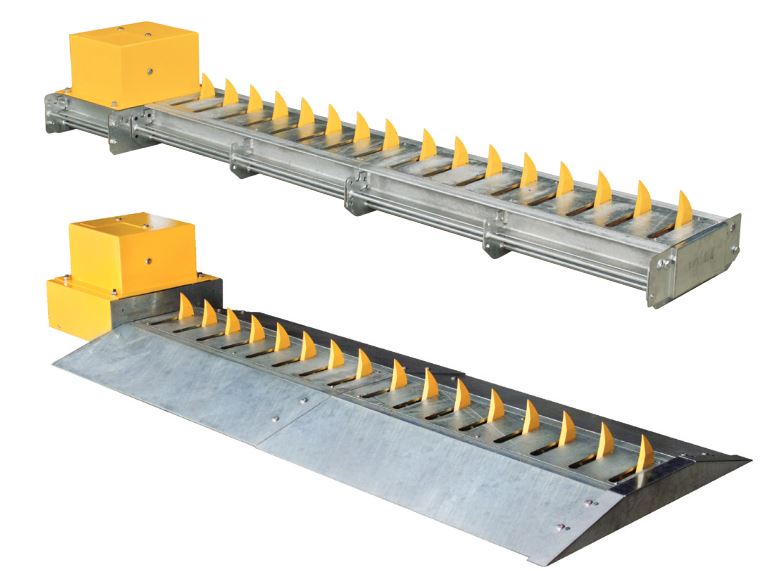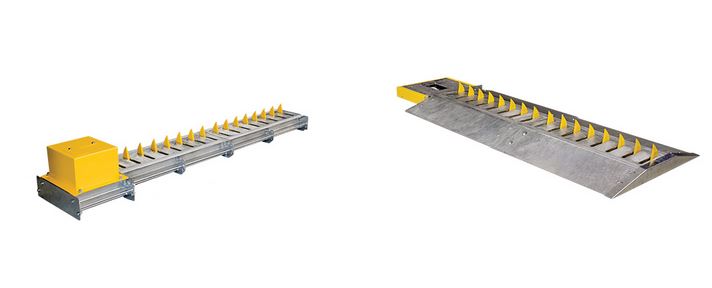Roadway Spikes
In the realm of modern transportation, highways serve as the lifelines of connectivity. Indeed, a good highway facilitates the movement of people, goods, and services. With the ever-increasing volume of vehicles on the roads, it becomes imperative to implement measures that facilitate smooth traffic flow and overall road safety. One such measure that has gained traction in recent years is the utilization of road claws. ORACO Kenya is an installer of roadway spikes and traffic barrier claws in Kenya.

Roadway claws, commonly referred to as traffic spikes or road claws, are mechanical devices installed on roadways to regulate and control traffic flow. These equipment are typically installed on the surface of road lanes or entry/exit points of facilities. Ideal places for installation include such as parking lots, toll booths, and other protected areas. Essentially, they are designed to puncture the tires of vehicles that attempt to travel in the wrong direction or without proper authorization.
Road Spikes Price in Kenya
| Price | KES 650,000 |
| Equipment length | 3 meters |
| Key components | automatic claws, DC motor, SECTOR controller and gearbox |
| Power supply and backup battery | yes |
| Complementing systems | boom barriers, |
| Models | Flush mount and surface mount |
| Ideal areas of installation | commercial office buildings, shopping malls, 5 star hotels, VIP residence |
| Setup | Installation at controlled entrance and exit |
Types of Roadway Claws
Fixed Road Claws: These are stationary and are installed permanently on the road surface. They are usually used at the exit points of parking lots to prevent vehicles from re-entering through the exit lane.
Retractable Roadway Claws: These ones can be raised or lowered as needed. They are often used at entry/exit points of facilities to allow authorized vehicles to pass while preventing unauthorized access.
One-Way Traffic Claws: These are designed to allow vehicles to travel in only one direction. They are often employed on streets or lanes with high traffic volume to regulate the flow of vehicles.
Emergency Vehicle Bypass Claws: These can be retracted in response to emergency vehicles, allowing them to pass through without any obstruction.
see; best CCTV camera installer
Benefits of Roadway Spikes
Unauthorized Access Prevention: the claws act as a deterrent against unauthorized vehicles attempting to gain access to protected areas. They can be installed at military barracks, VIP residential areas, and other private facilities or restricted zones.

Enhanced Road Safety: One of the most significant advantages of roadway claws is their potential to enhance road safety. By deterring speeding and enforcing traffic rules, these devices contribute to reducing the occurrence of accidents caused by reckless driving. When drivers adhere to speed limits and designated lanes, it leads to safer driving behavior.
Traffic Flow Management: this highway management solution provide an effective means of managing traffic flow, particularly in areas prone to congestion. By discouraging speeding and encouraging compliance with speed limits, traffic claws help maintain a steady flow of vehicles, reducing the likelihood of sudden stops or gridlocks.
Also, they play a pivotal role in regulating traffic flow by ensuring that vehicles follow designated routes and lanes. This is particularly crucial in areas with complex traffic patterns or high congestion. When implemented either as fixed or retractable, they can prevent drivers from entering areas or lanes in the wrong direction. This reduces the risk of head-on collisions and accidents.
Crime Prevention: this solution plays a key role in preventing criminal activities such as unauthorized border crossings or vehicle theft. For example, installing fixed claws at border checkpoints can discourage illegal entries. Still, their deployment at strategic locations can impede the escape of stolen vehicles. By controlling the access points of facilities, these equipment contribute to overall security measures by restricting entry to authorized personnel only.
Cost-Effective Solution: Implementing this solution can be a cost-effective solution compared to other traffic control measures or law enforcement methods. Once installed, these devices require relatively minimal maintenance and operational costs.
The Future of Traffic Claws
As technology continues to evolve, the future of traffic claws holds promising advancements aimed at addressing current challenges and enhancing their effectiveness.
To start with, the equipment can incorporate smart sensors. This can improve their responsiveness to emergency vehicles and enhance safety by retracting spikes when not needed. Furthermore, we the emergence of hybrid solutions. Combining roadway spikes with other traffic management technologies, such as automatic gates and automated boom barriers, can create more comprehensive control systems.
Road spikes serve as valuable tools in the realm of traffic management and road safety. They regulate traffic flow, preventing wrong-way entry, and enhancing security. Also, they contribute to the overall efficiency and safety of road networks and facilities. However, challenges such as driver awareness and maintenance must be carefully addressed.
As technology advances, the future holds the promise of smarter, more integrated roadway spike systems that further enhance their effectiveness and mitigate existing concerns. Through a balanced approach that prioritizes safety, efficiency, and innovation, traffic claws are poised to continue playing a vital role in shaping the landscape of modern transportation.
Considerations before implementation
While traffic claws offer several benefits, their implementation requires careful consideration and planning to ensure their effectiveness and minimize potential drawbacks. Here are some key factors to take into account.
Strategic Placement: the equipment should be strategically placed at locations where their deployment is most effective, such as toll booths, border crossings, or accident-prone areas. Extensive analysis of traffic patterns and risk factors is essential to determine optimal placement.

Communication and Signage: Adequate communication and signage are crucial to inform drivers of the presence of the claws. Clear and visible signage should be placed well in advance to provide drivers with sufficient time to slow down and comply with traffic regulations.
Emergency Situations: Contingency plans must be in place to address emergency situations, such as medical emergencies or vehicle malfunctions, where immediate access is required. Mechanisms for retracting the spikes in real-time should be established to prevent undue harm.
Maintenance and Monitoring: Regular maintenance and monitoring of highway claws is essential to ensure their functionality. Routine inspections, cleaning, and repairs should be carried out to prevent malfunction or unintended damage to vehicles.
see; Fortinet firewall
Legal Considerations: Implementing highway management solution like this one requires legal considerations. Therefore, road users must adhere to the existing traffic laws, regulations, and guidelines.
Emergency Vehicle Passage: The use of emergency vehicle bypass claws ensures that emergency services can navigate through traffic seamlessly. Specialized vehicles such as police response vans, firefighting trucks, and ambulances require special passage during emergency. In so doing, it allows for quicker response times during critical situations.
Understanding Roadway Spikes
The primary function of roadway spikes is to enforce speed limits and control traffic. They also enhance safety at locations such as toll booths, border crossings, or high-risk areas. When activated, highway claws puncture the tires of vehicles that fail to adhere to speed limits or other traffic regulations. This puncturing action forces the driver to reduce speed or come to a stop. Some other times, the vehicle can pull over safely thereby preventing potential accidents or unauthorized entries.
see; biometric time attendance system
This equipment is usually installed strategically placed on highway surfaces to regulate traffic flow in a certain direction. Typically constructed from durable materials such as high-strength steel or composite alloys, these claws are engineered to puncture the tires of vehicles that come into contact with them. The spikes can be retractable, meaning they can be deployed or retracted as needed, or they can be fixed in place.
see; best payroll software for small business
In the pursuit of safer and more efficient highway transportation, traffic claws have emerged as a viable technology for safety and traffic management. Their strategic placement, efficient functionality make them a valuable tool in addressing road use challenges. For instance, they easily address highway use challenges such as speeding, congestion, and unauthorized entries. However, successful implementation requires careful planning, public awareness communication, and adherence to legal considerations. As technology continues to evolve, this solution remain a noteworthy innovation in the realm of traffic control and safety.
Contact us now by filling the form below



